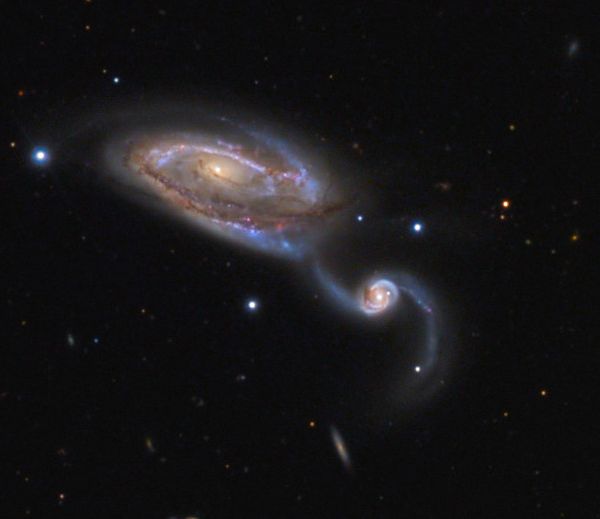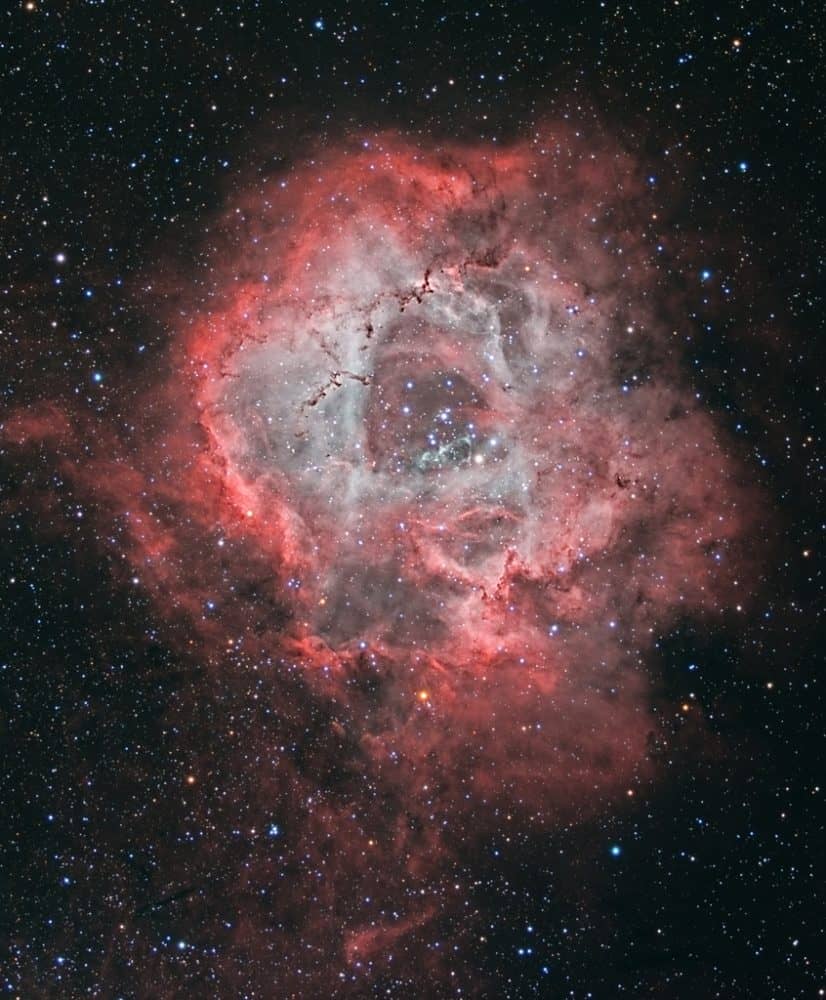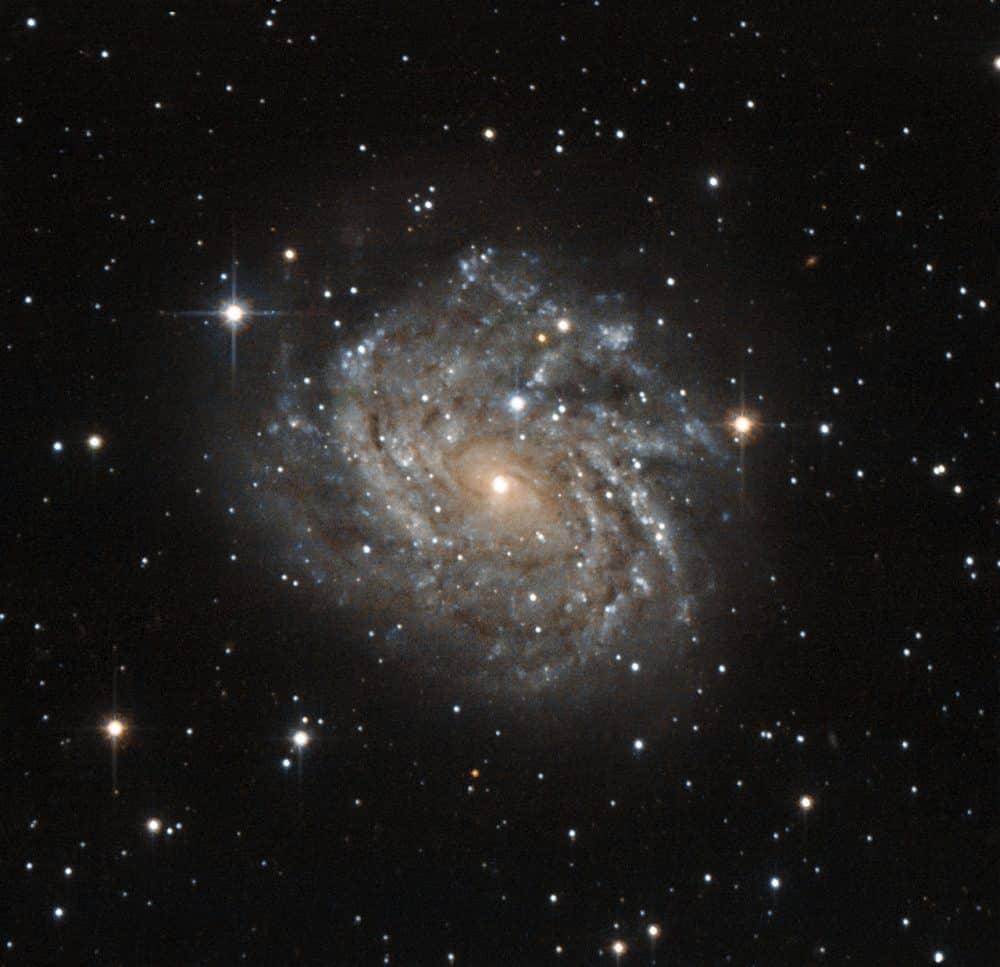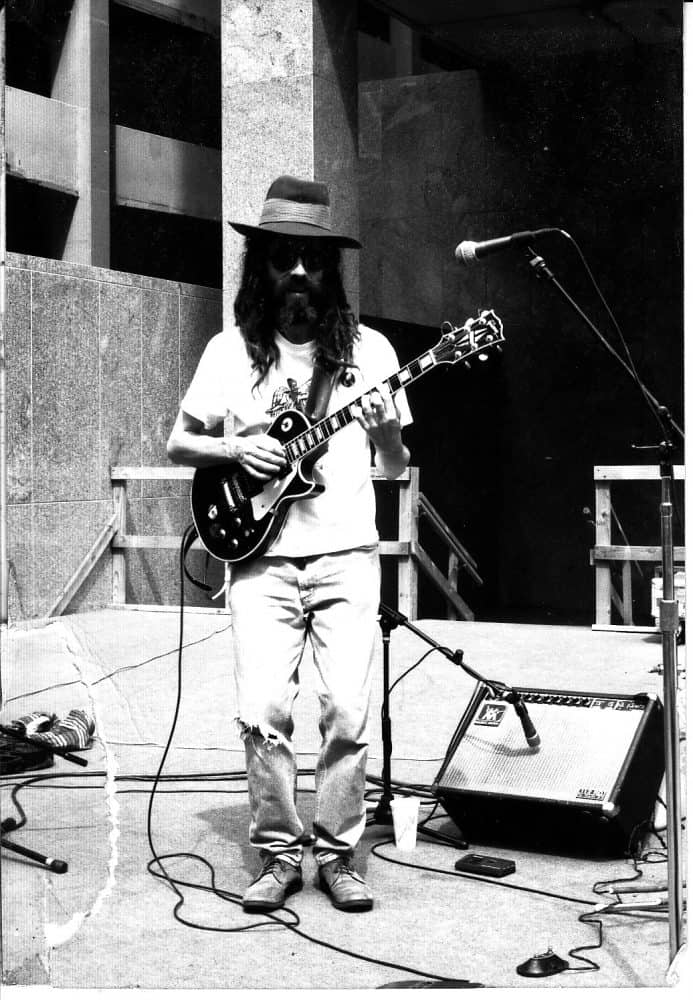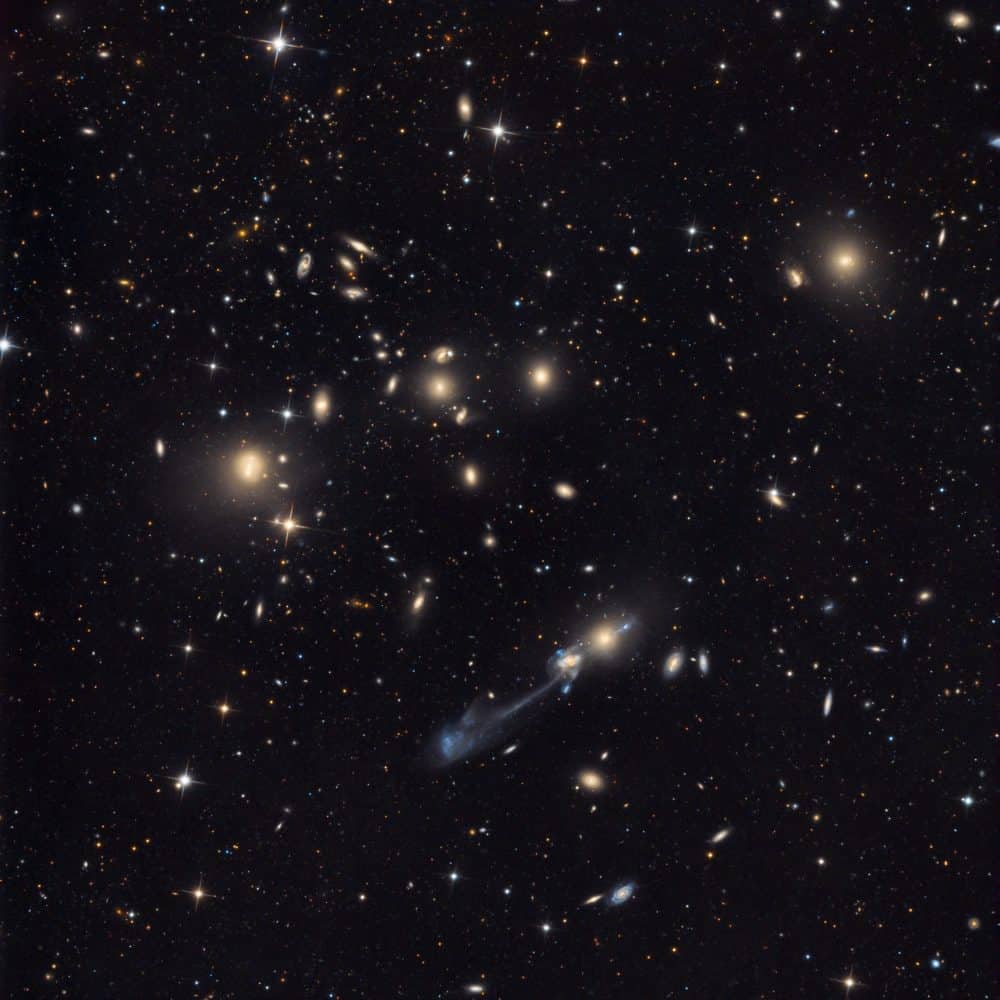Blog
NGC 5395 and 5394, together known as Arp 84 or the Heron Galaxy, are two interacting galaxies located just over 160 million light-years away from Earth in the small northern constellation of Canes Venatici (the Hunting Dogs). It takes little imagination to see a blue heron’s body, complete with neck, head and a beak reaching out to a nearby fish.
The larger, NGC 5395, is a somewhat elongated, nearly face-on spiral galaxy of about 140 thousand light-years across, located about 162 million light-years away from Earth, while it receding from us at approximately 3511 kilometers per second. NGC 5394, also face-on galaxy, is a barred spiral of about 90 thousand light-years across, located 161 million light-years away, while it is receding from us at approximately 3448 kilometers per second.
The main disk of NGC 5395, with a bright, elongated central region, is asymmetric and distorted due to interaction with its nearby companion NGC 5294. The dominant spiral arm of this two-armed spiral galaxy forms a large ring somewhat off center with respect to the nucleus. Obscuring dust lanes can be seen throughout the galaxy.
The smaller galaxy, NGC 5394, has an oval disk, two long, fairly symmetric, open tidal arms, and very bright inner spiral arms, disjoint from the outer tidal arms. Most of the gas in NGC 5394 is concentrated around the center, so is suitable for fueling the ongoing starburst in its center. Despite the presence of hydrogen gas, two of the three inner spiral arms of NGC 5394 show no evidence of ongoing star formation.
On June 25, 2000 the Type Ic supernova SN 2000cr was discovered in NGC 5395, northeast of the nucleus.
Types Ic (and Ib) supernovae are caused by the core collapse of massive stars and are usually referred to as stripped core-collapse supernovae. These stars have shed (or been stripped of) their outer envelope of hydrogen, and lack the absorption line of silicon. Compared to Type Ib, Type Ic supernovae have lost more of their initial envelope, including most of their helium.
more...John William Casady (born April 13, 1944) is an American bass guitarist, best known as a member of Jefferson Airplane and Hot Tuna. Jefferson Airplane became the first successful exponent of the San Francisco Sound. Their singles, including “Somebody to Love” and “White Rabbit“, had a more polished style than their other material, and successfully charted in 1967 and 1968. Casady, along with the other members of Jefferson Airplane, was inducted into the Rock and Roll Hall of Fame in 1996. Casady was born in Washington D.C., the son of Mary Virginia (née Quimby) and William Robert Casady. His father was of half Irish Protestant and half Polish Jewish ancestry. His mother was a relative of aviator Harriet Quimby; some of her family had been in North America since the 1600s.
Edwin “Eddie” Marshall (April 13, 1938 – September 7, 2011) was an American jazz drummer. Marshall was born in Springfield, Massachusetts. He played in his father’s swing group and in R&B bands while in high school. He moved to New York City in 1956, developing his percussion style under the influence of Max Roach and Art Blakey. Two years later he played in the quartet of Charlie Mariano and with Toshiko Akiyoshi; after two years’ service in the Army, he returned to play with Akiyoshi again in 1965. He worked with Mike Nock for a year in the house band of the New York nightclub The Dom, and also worked with Stan Getz and Sam Rivers, and accompanied Dionne Warwick on tours.
In 1967 he was a member of The Fourth Way, a fusion group which included Nock, Michael White, and Ron McClure. This group toured the San Francisco Bay Area through the early 1970s; after this Marshall played with Jon Hendricksand The Pointer Sisters.
Marshall was a member of the group Almanac with Bennie Maupin (flute, tenor saxophone), Cecil McBee (bass) and Mike Nock (piano). They released one album in 1977.
In the 1980s he worked in the project Bebop & Beyond, who recorded tribute albums to Dizzy Gillespie and Thelonious Monk.
more...Lawrence “Bud” Freeman (April 13, 1906 – March 15, 1991) was an American jazz musician, bandleader, and composer, known mainly for playing the tenor saxophone, but also able at the clarinet. He had a smooth and full tenor sax style with a heavy robust swing. He was one of the most influential and important jazz tenor saxophonists of the big band era. His major recordings were “The Eel”, “Tillie’s Downtown Now”, “Crazeology”, “The Buzzard”, and “After Awhile”, composed with Benny Goodman.
Freeman was born on April 13, 1906, in Chicago. In 1922, he and some friends from high school formed a jazz group, the Austin High School Gang, Freeman played the C melody saxophone alongside his other band members such as Jimmy McPartland and Frank Teschemacher before switching to tenor saxophone two years later. Influenced by artists like the New Orleans Rhythm Kings and Louis Armstrong from the South, they would begin to formulate their own style, becoming part of the emerging Chicago Style of jazz.
In 1927, he moved to New York, where he worked as a session musician and band member with Red Nichols, Roger Wolfe Kahn, Ben Pollack, Joe Venuti, among others. One of his most notable performances was a solo on Eddie Condon‘s 1933 recording, The Eel, which then became Freeman’s nickname (for his long snake-like improvisations). Freeman played with Tommy Dorsey’s Orchestra (1936–1938) as well as for a short time Benny Goodman‘s band in 1938 before forming his own band, the Summa Cum Laude Orchestra (1939–1940). Freeman joined the US Army during World War II, and headed a US Army band in the Aleutian Islands.
https://www.youtube.com/watch?v=dD9V9wB6ka4
more...https://www.youtube.com/watch?v=9ffTSqyzIM0
more...The Rosette Nebula, NGC 2237, is not the only cosmic cloud of gas and dust to evoke the imagery of flowers, but it is the most famous. At the edge of a large molecular cloud in Monoceros some 5,000 light years away, the petals of this cosmic rose are actually a stellar nursery. The lovely, symmetric shape is sculpted by the winds and radiation from its central cluster of hot young, O-type stars. Stars in the energetic cluster, cataloged as NGC 2244, are only a few million years young, while the central cavity in the Rosette Nebula, is about 50 light-years in diameter. The nebula can be seen with a small telescope toward the constellation ofMonoceros, the Unicorn. This natural appearing telescopic portrait of the Rosette Nebula was made using broadband and narrowband filters, because sometimes roses aren’t red.
more...Herbert Jeffrey Hancock (born April 12, 1940) is an American pianist, keyboardist, bandleader, composer and actor. Hancock started his career with Donald Byrd. He shortly thereafter joined the Miles Davis Quintet where he helped to redefine the role of a jazz rhythm section and was one of the primary architects of the post-bop sound. In the 1970s, Hancock experimented with jazz fusion, funk, and electro styles.
Hancock’s best-known compositions include “Cantaloupe Island“, “Watermelon Man” (later performed by dozens of musicians, including bandleader Mongo Santamaría), “Maiden Voyage“, “Chameleon“, and the singles “I Thought It Was You” and “Rockit“. His 2007 tribute album River: The Joni Letters won the 2008 Grammy Award for Album of the Year, only the second jazz album to win the award, after Getz/Gilberto in 1965.
Hancock was born in Chicago, Illinois, the son of Winnie Belle (Griffin), a secretary, and Wayman Edward Hancock, a government meat inspector. His parents named him after the singer and actor Herb Jeffries. He attended the Hyde Park Academy. Like many jazz pianists, Hancock started with a classical music education. He studied from age seven, and his talent was recognized early. Considered a child prodigy, he played the first movement of Mozart‘s Piano Concerto No. 26 in D Major, K. 537 (Coronation) at a young people’s concert on February 5, 1952, with the Chicago Symphony Orchestra (led by CSO assistant conductor George Schick) at the age of 11.
https://www.youtube.com/watch?v=emZqjQHXY_I
more...Shakey Jake Harris (April 12, 1921 – March 2, 1990) was an American Chicago blues singer, harmonicist and songwriter. He released five albums over a period of almost 25 years. He was often musically associated with his nephew Magic Sam.
James D. Harris was born in Earle, Arkansas, and relocated with his family to Chicago, Illinois, at the age of seven. He played in several Chicago blues ensembles in the late 1940s. He also worked as a mechanic and as a professional gambler (his nickname came from a dice players’ expression, “shake ’em”). His debut recording was the single “Call Me if You Need Me”, backed with “Roll Your Moneymaker”, released by Artistic Records in 1958, featuring Magic Sam and Syl Johnson on guitar and produced by Willie Dixon. Harris was not paid for the session, but he won $700 shooting craps with label owner Eli Toscano.
more...
Theodore Roosevelt “Hound Dog” Taylor (April 12, 1915 – December 17, 1975) was an American Chicago blues guitarist and singer.
He was famous among guitar players for having six fingers on both hands, a condition called polydactyly. As is usual with the condition, the extra digits were rudimentary nubbins and could not be moved. One night, while drunk, he cut off the extra digit on his right hand using a straight razor.
He became a full-time musician around 1957 but remained unknown outside the Chicago area, where he played small clubs in black neighborhoods and at the open-air Maxwell Street Market. He was known for his electrified slide guitar playing (roughly styled after that of Elmore James), his cheap Japanese Teisco guitars, and his raucous boogie beats.
more...Flamenco Fridays with Encarna Anillo y Juan Diego performing Bulerias
“Bulería” is the most characteristic flamenco style of Jerez de la Frontera. It is generally composed of three or four eight-syllable verses. This is one of the most complex dancing and guitar styles: bustling, happy and cheerful.
It is characterised by a fast rhythm and a redoubled beat. It is more suitable than other flamenco styles to be sung accompanied by flamenco clapping, “jaleo” and other shouts and expresive voices. “Bulerías” constitute an usually dance to finish all flamencos parties (composing a semicircle, people dance in the middle of it a part of the song). The most flamenco “bulerías” are in Phrygian mode (with the I chord mutation that becomes Major perfect, often combining melodic and harmonic turns on the I and VI).
more...
LEDA 89996, also known by its 2MASS designation 2MASS J04542829-6625280, is a spiral galaxy. It is located within the Dorado constellation and appears very close to the Large Magellanic Cloud.
The galaxy was observed by the Hubble Telescope in 6 July 2015 and is similar in appearance to the Milky Way being spiral shaped with winding spiral arms. The darker patches between the arms is dust and gas. Lots of new stars form in this area making the spirals appear very bright.
more...William Wampach (April 11 1951) Born St Cloud, MN. Mostly know as a Electric Guitarist also a songwriter, painter, sculptor and artist. Growing up in Brooklyn Center, Mn. Will worked with bands like Blackbone, Angry Souls, The Mystic Evolution, CCLC. Later Will delved into Calypso and Reggae with Lloyd Cordner in Macumba, later working with Peter Nelson in Shangoya touring Trinidad. Will then became guitarist in the Maroons a Minneapolis based premier Rock Steady/Reggae group blending R&B, Rock and Human Rights issues.
more...John Levy (April 11, 1912 – January 20, 2012) was an African-American jazz double-bassist and businessman.
Levy was born in New Orleans, Louisiana. In 1944, he left his family home in Chicago, Illinois, and moved to New York City, New York, where he played bass for such renowned jazz musicians as Ben Webster, Erroll Garner, Milt Jackson, and Billie Holiday. In 1949, he became the bassist in the original George Shearing Quintet, where he also acted as Shearing’s road manager. In 1951, Levy opened John Levy Enterprises, Inc., becoming the first African-American personal manager in the pop or jazz music field. By the 1960s, Levy’s client roster included Shearing, Nancy Wilson, Cannonball Adderley, Joe Williams, Shirley Horn, Soul singer Jimmie Raye, and Ramsey Lewis.
In 1997, Levy was inducted into the International Jazz Hall of Fame, and in 2006 he was named a Jazz Master by the National Endowment for the Arts. He died, aged 99, in Altadena, California.
more...Rim Banna (Arabic: ريم بنا; 8 December 1966 – 24 March 2018) was a Palestinian singer, composer, arranger and activist, who was most known for her modern interpretations of traditional Palestinian songs and poetry. Banna was born in Nazareth, where she graduated from Nazareth Baptist School. She lived in Nazareth with her three children. She met her husband, Ukrainian guitarist Leonid Alexeyenko, while studying music together at the Higher Music Conservatory in Moscow and they married in 2001, and got divorced in 2010.
Banna died in her hometown of Nazareth on 24 March 2018 following a nine-year struggle with breast cancer.
more...Arp 105 is in a spectacular field of galaxies. It’s in the class E and E-like Galaxies Connected to Spirals. The Arp is the long structure running N-S, about halfway from the center of the field to the east edge. The brighter galaxy to the south is NGC 3561 and the companion, about 1′ north, is NGC 3561A. The little elliptical(?) just south of NGC 3561 is known as Ambartsumian’s Knot. As you can see, there are quite a few other knots, galaxies, etc., in this structure. Also in the field, NGC 3550 is the bright object toward the northwest corner, just west of the bright star. There are three more NGC’s, 3553, 52, and 54, all in a line starting not quite 4′ south of 3550 and angling SSE. NGC 3553 is not particularly bright — there are a number of brighter galaxies in the field that did not make the better known catalogs. The entire field is completely inside Abell Galaxy Cluster 1185.
more...Omar Sosa (born April 10, 1965) is a Cuban-born composer, bandleader, and jazz pianist. Born in Camagüey, Cuba, Sosa began studying marimba at the age of eight, then switched to piano at the Escuela Nacional de Musica in Havana, where he studied jazz. Sosa moved to Quito, Ecuador, in 1993, then San Francisco, California, in 1995. In San Francisco he became deeply involved in the local Latin jazz scene and began a long collaboration with percussionist John Santos. He also made a series of recordings with producer Greg Landau, including the ground-breaking Oaktown Irawo, featuring Tower of Power drummer Dave Garibaldi, Cuban saxophonist Yosvany Terry and Cuban percussionist Jesus Diaz. Sosa and Landau recorded with Carlos “Patato” Valdes and Pancho Quinto and worked on several film scores. Around 1999 Sosa moved to Barcelona, Catalonia.
More Posts
- Flamenco Fridays with Maria Albaicin
- Daily Roots with Third World
- Surviving the Pandemic and Realizing Racial Justice
- The Cosmos with Aurora Borealis from ISS
- Allen Toussaint
- Grady Tate
- Kenny Wheeler
- World Music with Coreyah
- Daily Roots with Vox Sambou Ft. Luciane
- Surviving the Pandemic and Realizing Racial Justice
- The Cosmos with GAL-CLUS-022058s
- Joe Pass
- Melba Liston
- Danny Barker
- World Fusion with Labess
- Daily Roots with the Skulls
- Surviving the Pandemic and Realizing Racial Justice
- The Cosmos with NGC 1097
- George Duke
- Long John Baldry
